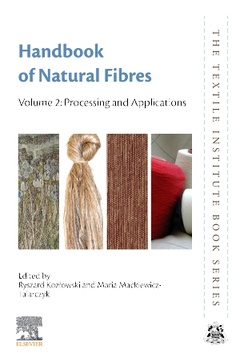Description
Handbook of Natural Fibres (2nd Ed.)
Volume 2: Processing and Applications
The Textile Institute Book Series
Coordinators: Kozlowski Ryszard M., Mackiewicz-Talarczyk Maria
Language: English
Subjects for Handbook of Natural Fibres:
752 p. · 15x22.8 cm · Paperback
Description
/li>Contents
/li>Readership
/li>Biography
/li>Comment
/li>
The Handbook of Natural Fibres: Volume Two, Processing and Applications, Second Edition provides detailed coverage of the latest processing techniques and industrial applications of a wide range of natural fibers. Natural fibrous resources, both lignocellulosic and protein ones, are renewable, biodegradable, and nontoxic, making them an important source of sustainable textile solutions. A broad range of sources of natural fibers are covered in the book, including flax, hemp, bast, jute, coir, linen, cotton and silk. This wealth of expert information provides a uniquely detailed reference for the processing, characterization, selection and application of natural fibers.
Part One Processing techniques for natural fibres 1 Cotton fibres, picking, ginning, spinning and weaving 2 Processing of jute fibres and its applications 3 Silk e production and future trends 4 The use of flax and hemp for textile applications 5 Use of bast fibres including flax fibres for high challenge technical textile applications. Extraction, preparation and requirements for the manufacturing of composite reinforcement fabrics and for geotextiles 6 Multi-scale mechanical characterization of flax fibres for the reinforcement of composite materials 7 Enzymatic treatment of natural fibres 8 Improving the properties of natural fibres by chemical treatments 9 Electrokinetic properties of natural fibres 10 Improving the flame retardancy of natural fibres 11 Bast fibres: the role of hemp (Cannabis sativa L.) in remediation of degraded lands 12 Medical potential of cannabis: an overview
Part Two Applications and case studies for natural fibres 13 Chemical and physical characteristic of modified cotton and linen fabrics with amine-terminated dendritic polymer 14 Natural fibre composites (NFCs) for construction and automotive industries 15 Natural fibres for geotextiles 16 Properties and applications of ultrafine powders produced from natural fibres 17 The application of flax and hempseed in food, nutraceutical and personal care products 18 Natural fibres for paper and packaging 19 Environmental textiles from jute and coir 20 Antimicrobial natural fibres 21 Biomimetics and textile materials
Engineers and materials scientists working with natural fibres in industries including apparel, automotive, sporting goods, and construction. Researchers in the field of natural fibres and related products
Maria Mackiewicz-Talarczyk is assistant at Institute of Natural Fibres and Medicinal Plants in Poland.
- Connects natural fibers to a wide range of industries, including construction, automotive, packaging and medical
- Helps readers appraise natural fibers on the basis of their mechanical, electrokinetic, antimicrobial or flame retardant qualities
- Provides a rare glimpse of emerging manufacturing methods for silk




